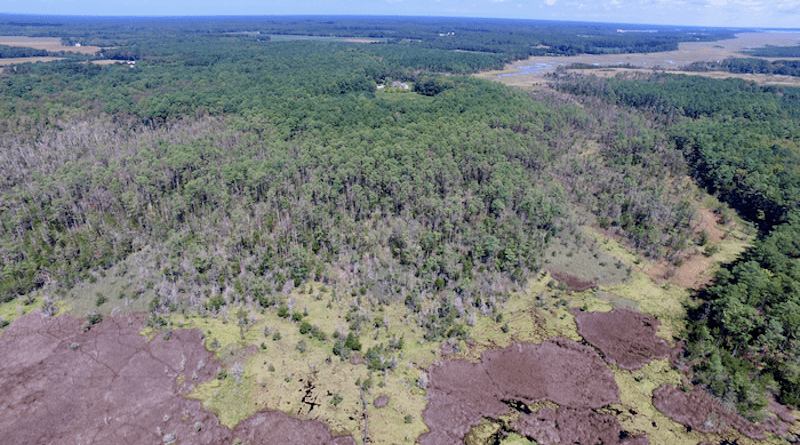Rural Areas Will Bear The Brunt Of US Sea-Level Rise
It’s hotly debated whether coastal wetlands can survive sea-level rise by migrating inland. A new analysis using highly detailed elevation maps of the Chesapeake Bay region shows that—contrary to previous studies—human barriers will do little to slow this marsh migration. Instead, extensive areas of low-lying rural land will allow coastal marshes to persist or even expand as salty water creeps upward into what are now forests and farmland.
Lead author Grace Molino, a Ph.D. student at William & Mary’s Virginia Institute of Marine Science, says “The numbers are striking. Baywide, we expect more than 600 square miles of inundated land in the Chesapeake region by 2100.” That is four times the area that has converted to marshland in the Bay region since historical observations began in the 1840s, and more than 75% will be rural—mainly forests, forested wetlands, and farm fields.
Joining Molino on the study, which appears in the latest issue of Limnology and Oceanography Letters, are VIMS professor Dr. Matt Kirwan along with U.S. Geological Survey researchers Joel Carr of the Eastern Ecological Science Center and Neil Ganju of the Woods Hole Science Center. The study was made possible with funding from the USGS and collaboration between VIMS and the two USGS Science Centers.
“As far as I know, this is the first projection of inundated land in the Bay area, and one of the few and most high-resolution predictions in the U.S.” says Kirwan. “Our analysis shows that marsh migration is constrained more by natural topography than by human development.”
The authors stress that their findings apply not just to the mid-Atlantic region, as similar land-use patterns occur all along the U.S. coastline. “Our data suggests that rural coasts will bear the brunt of sea-level rise nationwide,” says Kirwan.
The team’s study paints the Chesapeake region and North American coastal plain as global outliers in terms of saltmarsh resilience to sea-level rise, with the more urbanized coasts of Europe and Asia more likely to experience “coastal squeeze.” This is the loss of coastal wetlands as rising saltwater floods and erodes their seaward edge while natural or human barriers block their landward migration.
Says Kirwan, “Despite a perception that urban centers will block marsh migration, our predictions suggest that the most vulnerable land in the Chesapeake Bay remains largely undeveloped, even in what are typically thought of as urban watersheds.”
“We found that developed lands generally occupy less than 10% of predicted migration areas within individual watersheds even under our high scenarios of sea-level rise,” adds Molino, “despite more extensive development in the watershed overall.”
For example, the Elizabeth River is one of the most highly developed watersheds in the Chesapeake Bay and the U.S., with its three branches cutting through the metropolitan areas of Norfolk and Portsmouth in southeast Virginia. Yet developed surfaces occupy only 16% of the potential marsh-migration area under 1 meter of sea-level rise, compared to 31% of developed land across the entire watershed.
The Bay’s other major urban areas—Hampton, Virginia; Annapolis, Maryland; and Baltimore, Maryland—lie in more elevated watersheds with only small areas of potential marsh migration.
The good news from the study is that the abundance of low-lying forests and farmland in the Chesapeake Bay area and North America more generally will largely preclude coastal squeeze expected to curtail saltmarsh area in other, more urbanized regions of the world’s coast.
The challenge for North American landowners and governments will be to equitably manage the conversion of what is now mostly privately owned, income-producing rural uplands into coastal wetland habitats whose value lies mainly in providing publicly valued ecosystem services such as flood protection and the nurture of fish and bird populations.
Analysis
The team began their analysis by using more than 200,000 GIS data points to map the present-day boundary between forest and marsh around the Bay. They then recorded the height of each point relative to sea level using an extremely detailed elevation model from the U.S. Geological Survey. Their next step was to use these data points to calculate a median “threshold elevation” for each of 81 watersheds surrounding Chesapeake Bay.
Akin to a bathtub ring, the threshold elevation integrates the mix of tidal range and salinity that has advanced the marsh-migration front to its current height and lateral position within each watershed segment. These threshold elevations vary by a factor of 5 across the 81 watersheds, from 0.2 to 1.05 meters (0.65-3.4 feet). The boundary extends farthest inland in low-lying watersheds bordered by salty waters with a high tidal range. Regular inundation by saltwater is the main factor that converts farmlands and forests into saltmarsh.
Using the same high-resolution USGS map, the team then added increments of sea-level rise out to 2100 based on projections by the National Oceanic and Atmospheric Administration—including a low (0.5 m or 1.6 feet), intermediate (1 m or 3.3 ft), and high (2.5 m or 8.2 ft) scenario. They then measured the area of land within each watershed that would be flooded under each sea-level-rise scenario, and determined whether it is currently covered by forest, forested wetlands, turf grass, farm fields, or developed surfaces such as roads, parking lots, and buildings.
As expected, these “potential marsh migration areas” will increase over the coming decades and with the magnitude of sea-level rise, from 405 square miles by 2100 under their low scenario to 1,447 square miles under their high scenario.
What was unexpected within the increasingly developed Chesapeake Bay watershed is that the marsh-migration areas are dominated by upland and wetland forests, not urban or suburban land.

